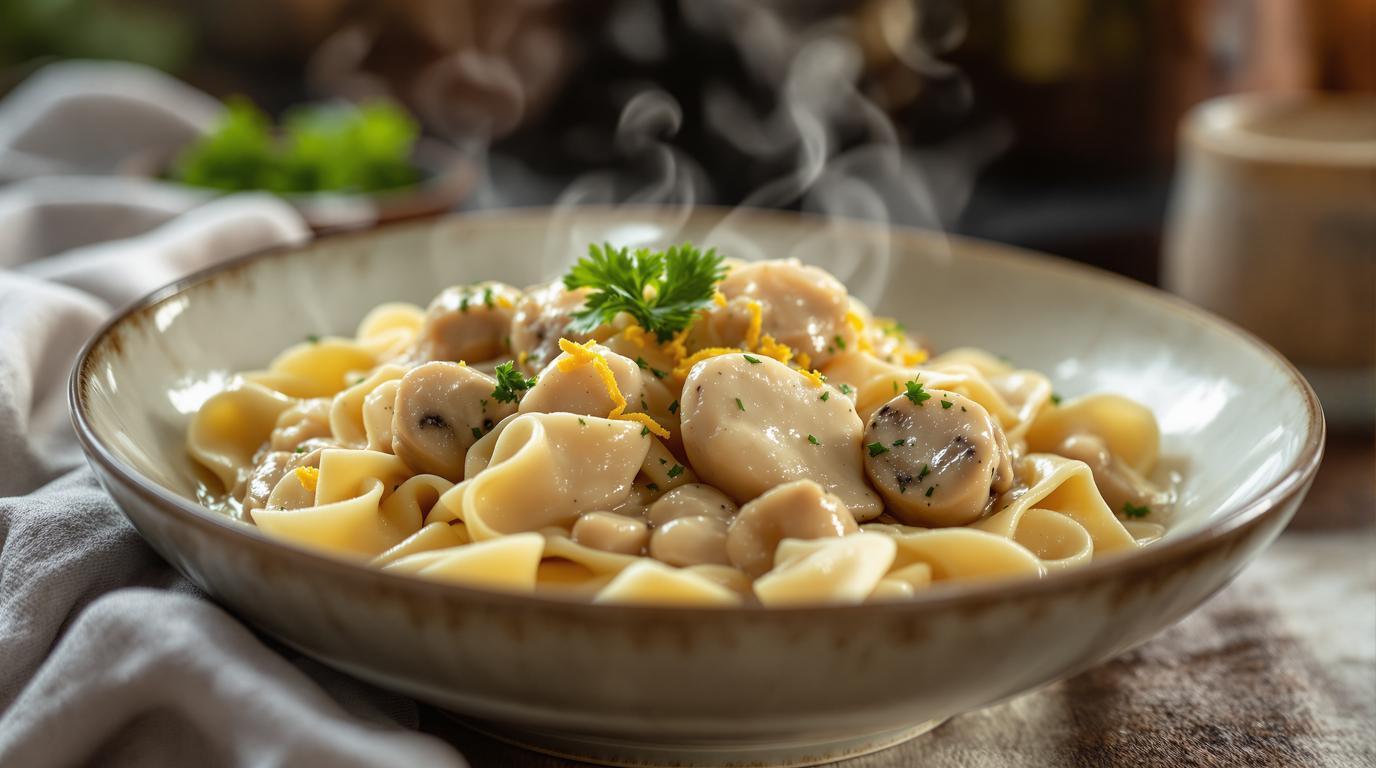The first time I made a true Blanquette de Veau, I was working in a small bistro in Lyon. What struck me wasn’t just the comforting aroma filling the kitchen, but the revelation that such profound flavor could come from a dish where nothing is browned. That’s the magic of this French classic – it breaks the cardinal rule of building flavor through caramelization, yet delivers something equally magnificent through gentle technique. The velvety sauce, created from the marriage of reduction and liaison, transforms humble veal into something that feels simultaneously rustic and refined. It’s grandmother’s cooking elevated to restaurant quality, yet perfectly achievable at home.
The Story Behind the Blanquette
The Blanquette de Veau traces back centuries in French cuisine, originally using almond milk before evolving to include cream and egg yolks after the Renaissance. The name itself refers to “blanc” (white), highlighting its defining characteristic – a pale, creamy presentation that stands in contrast to the darker, more rustic stews of French provincial cooking. While regional variations exist, the essence remains: tender veal gently poached and bathed in a sauce that’s simultaneously rich and bright.
Ingredients Spotlight
For the stew base (4 servings):
- 2.2 lbs (1 kg) veal shoulder or breast, cubed into 2-inch pieces
- 1 large white onion, studded with 2-3 cloves
- 2 leeks (white and light green parts), cleaned and sliced
- 2 medium carrots, cut into 1-inch chunks
- 1 bouquet garni (bay leaf, thyme sprigs, parsley stems, leek section tied together)
- 1 cup (250ml) dry white wine
- Water to cover
For the finishing touches:
- 10 oz (300g) button or cremini mushrooms, halved or quartered if large
- 18 pearl onions, peeled
- 3.5 oz (100g) butter, divided
- 2 tbsp (25g) all-purpose flour
- 5 oz (150g) crème fraîche
- 3 large egg yolks
- 1 lemon (zest and 1 tbsp juice)
- Salt and white pepper to taste
- Fresh parsley, finely chopped
Step-by-Step Guide
Phase 1: Preparing the Foundation
- Place veal pieces in a pot of cold salted water, bring to a boil, and cook for 2 minutes to remove impurities. Drain completely and rinse with cold water.
- In a clean Dutch oven or heavy pot, combine blanched veal, sliced leeks, carrots, clove-studded onion, and bouquet garni.
- Add white wine and enough water to just cover the ingredients. Season lightly with salt.
- Bring to a gentle simmer (180-190°F/82-88°C) – you want tiny bubbles, not a rolling boil. Cover partially and cook for 75-90 minutes until veal is fork-tender.
Phase 2: Creating the Silky Sauce
- Remove meat and vegetables with a slotted spoon; set aside and keep warm.
- Strain the cooking liquid, reserving about 2 cups (500ml).
- In a separate saucepan, melt 1.5 oz (40g) butter over medium-low heat. Add flour and cook for 2 minutes without browning (this is crucial – we want a white roux).
- Gradually whisk in the hot strained broth until smooth, then simmer for 5 minutes until it coats the back of a spoon.
Chef’s Note: The liaison of egg yolks and cream is what transforms this dish from ordinary to extraordinary. Always temper your egg mixture by adding hot liquid slowly while whisking constantly. This prevents curdling and creates that signature silky texture.
Expert Techniques
The magic happens in the final assembly. In a bowl, whisk together crème fraîche, egg yolks, and lemon juice. Slowly add a ladle of hot sauce while whisking constantly to temper the mixture. Off heat, gradually incorporate this back into the main sauce, stirring continuously.
Meanwhile, melt remaining butter in a skillet and sauté mushrooms until golden and moisture has evaporated. Add pearl onions and cook until tender, about 5 minutes. Season with salt, pepper, and a splash of lemon juice.
Return the veal and vegetables to the sauce, add the mushroom mixture, and warm everything through gently for 10 minutes – never allow to boil after adding the liaison. Finish with lemon zest, fresh parsley, and a final seasoning adjustment.
Presentation & Pairing Ideas
Traditionally, Blanquette de Veau is served over steamed white rice, which provides the perfect canvas for absorbing the luxurious sauce. For a more contemporary approach, try wide pappardelle pasta or buttered new potatoes.
The dish pairs beautifully with a crisp Chablis or other unoaked Chardonnay, whose acidity cuts through the richness while complementing the delicate flavors. For contrast, serve alongside quick-sautéed bitter greens dressed with lemon – the brightness balances the creamy stew perfectly.
For a lighter spring variation, add fresh peas and asparagus tips during the final warming stage. In winter, increase the mushroom variety to include wild mushrooms for deeper earthy notes.
Remember, the true test of a perfect blanquette is that each element retains its identity while contributing to the whole. The veal should be tender but not falling apart, the sauce rich but not heavy. Master this balance, and you’ll understand why this classic has endured for centuries. Don’t be afraid to make it your own – the best traditions evolve with each cook who honors them. Explore more French classics or try other European-inspired recipes to expand your culinary repertoire.
